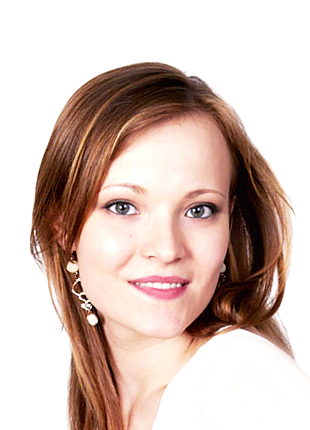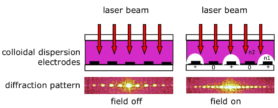
Anna Nikolaenkova MSc
Leonard S. Ornstein Laboratory, room 1.04
Princetonplein 1, 3584 CC Utrecht
P.O. Box 80 000, 3508 TA Utrecht
The Netherlands
phone: +31 (0)30 253 2925
secretariat: +31 (0)30 253 2952
e-mail: a.g.nikolaenkova@uu.nl
Research
Supervisors: dr. Patrick Baesjou and dr. Arnout Imhof
Promotor: Prof. dr. Alfons van Blaaderen
Responsive colloids for switchable optics
Generally, properties of matter such as colour and refractive index are static. Once imparted through synthesis, crafting, or shaping they remain unchanged throughout the lifetime of the material. However, there is a growing interest in responsive material systems with adjustable properties. Colloidal dispersion that consists of particles and the medium which have a difference in one of the properties is a way to make such systems [1]. By changing the distribution of particles it is possible locally change an overall optical behavior of colloidal sample. Phenomena of electrophoresis and dielectrophoresis are chosen as start methods of spatial manipulation of particles in our project [2,3].
The electrophoresis mechanism of colour manipulating has been already applied in electrophoretic displays (displays of e-readers) by company E-ink [4]. Particles with a different colour (black and white) and charge are dispersed in oil-filled capsules and can be moved by an electric field. Depending on the direction of the electric field the screen state switches between black and white.
The goal of our research is to create a novel option for switchable optics by manipulating with a refractive index of the colloidal system and to make a prototype of switchable Fresnel lens as a proof of concept.
On Fig.1 you can see a switchable grating as an example of such manipulating [5].
Figure 1: (Left) No electric field. Laser beam goes through a homogenous dispersion and forms diffraction pattern of electrodes grating. (Right) Electric field is on. Laser beam goes through non-homogeneous dispersion consisting of zones with higher and lower refractive indices. As a result, the double diffraction pattern appears.
[1] V.J. Novotny, J. Colloids and Surfaces 24, 361-375 (1987)
[2] T. Vissers et al., J. Colloid Interface Sci. 361, 443-455 (2011)
[3] M.E. Leunissen, J. Chem.Phys. 128, 164508 (2008)
[4] B. Comiskey et al., Nature 394, 253-255 (1998)
[5] M. Johnson et al., Patent No.WO 2008/062336 (2008)
